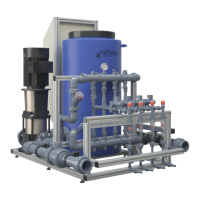14
NETAFLEX™ 3G USER MANUAL
OPERATION AND MAINTENANCE
Check the NetaFlex™ 3G hydraulic conditions every 4 weeks
Check the pressure gauge and the Rotameters of the dosing channels and compare the
data to the initial settings in the controller (NMC Pro - screen 7.6). Make sure that no significant
changes occurred to the hydraulic conditions of the NetaFlex™ 3G.
When verifying the flow rate for each dosing channel,
make sure the cursors on all the Rotameters are adjusted.
NOTE
The Rotameter's sacle is calibrated by the manufacturer for measurement of the
flow rate of water (H
2O). Certain inacuracies may be observed when the flow rate
of liquids with different densities, such as fertilizers and acids, is measured.
ATTENTION
Once a month, read the measured flow rates of the dosing channels
and compare them with the flow rates defined in the controller,
to check whether any changes have occurred.
Winterization
CAUTION
When opening or closing any manual valve, always do it gradually, to prevent damage to the
system by water hammer.
If
the NetaFlex™ 3G is located in an unheated space
where the temperature might drop below 5°C (41°F), if
the system is not required for irrigation during the winter, perform the following procedure
to avoid damage
caused by freezing when the NetaFlex™ 3G is idle for the winter period:
At the beginning of winter:
CAUTION
Before removing the EC and pH sensors, make sure there is no pressure in the system.
•
Remove EC and pH sensors and store the pH sensor immersed in KCL solution (supplied with the sensor)
or in calibration buffer 4 at temperature 18-25˚C (64-77˚F). The pH sensor must never be dry
(see the EC/pH Transmitter Manual).
• Empty the NetaFlex™ 3G of water.
At the end of winter:
NOTE
It is reccomended to install new
EC and pH sensors at the begining of a new season.
• Reinstall the EC and pH sensors and calibrate them (see the EC/pH Transmitter Manual).
• Restore the pressure in the system.

